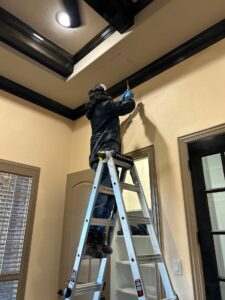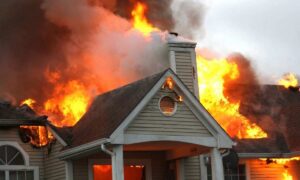Blogs
How does Intensa Dry handle structural damage during fire reconstruction?

Picture this: a fire has ravaged a building, leaving behind a mess of structural damage. That’s where Intensa Dry steps in with their expertise in fire damage restoration. But how exactly do they tackle the daunting task of reconstructing a fire-damaged structure? Well, let’s dive in! In this blog post, Intensa Dry helps to explore handling structural damage during fire reconstruction. From assessing the damage to integrating fire-resistant materials, they’ve got it all covered. So, grab a seat, and let’s uncover the secrets behind Intensa Dry’s impressive reconstruction techniques!
Assessment of Structural Integrity

The first step in Intensa Dry’s process involves a thorough assessment of the building’s structural integrity. Trained professionals conduct detailed inspections to identify the extent of the damage and determine which areas require immediate attention. This evaluation encompasses examining the integrity of load-bearing walls, floors, roofs, and other critical structural components. By conducting a meticulous assessment, Intensa Dry ensures that reconstruction efforts are targeted and efficient.
Assessment of structural integrity is a critical step in property restoration. Trained professionals thoroughly examine the building’s framework, walls, floors, and other structural elements to identify any damage or weaknesses caused by disasters like fires, floods, or storms. This assessment helps determine the extent of repairs or reinforcements needed to restore the property’s stability and safety. By conducting a comprehensive evaluation of structural integrity, restoration teams can develop effective restoration plans that prioritize structural stability, ensuring the safety and well-being of occupants.
Stabilization Techniques
Once the assessment is complete, Intensa Dry employs stabilization techniques to prevent further structural deterioration. This may involve shoring up weakened walls or reinforcing compromised supports to ensure the safety of workers and prevent collapse during reconstruction. Stabilization measures are essential for creating a secure environment conducive to effective reconstruction efforts.
Stabilization techniques are essential in property restoration, particularly when addressing structural damage. Professionals utilize various methods to secure and reinforce compromised structures, ensuring safety and preventing further deterioration. These techniques may include shoring, bracing, or temporary support systems to stabilize weakened areas. Additionally, anchoring systems and tie-downs may be employed to secure structures against external forces like wind or seismic activity. By implementing appropriate stabilization techniques, restoration teams mitigate risks, facilitate safer working conditions, and lay the foundation for successful reconstruction, ultimately restoring the property to its pre-damage condition.
Removal of Damaged Materials
After stabilizing the structure, the next step is the systematic removal of damaged materials. Intensa Dry’s team utilizes specialized equipment and techniques to safely eliminate fire-damaged elements such as charred wood, insulation, drywall, and debris. This meticulous process is crucial for preparing the site for reconstruction while also minimizing the risk of secondary damage or contamination.
In fire damage restoration services, the removal of damaged materials is a pivotal step. Restoration professionals systematically eliminate charred debris, compromised structural elements, and unsalvageable items from the affected property. This process not only clears the space for reconstruction but also mitigates safety hazards and prevents further damage. By promptly removing damaged materials, restoration teams expedite the restoration timeline and facilitate the rebuilding process. Additionally, thorough removal of debris minimizes the risk of contamination and ensures a clean environment for subsequent restoration efforts, ultimately restoring the property to its pre-fire condition.
Cleaning and Decontamination
In addition to removing visibly damaged materials, Intensa Dry places great emphasis on thorough cleaning and decontamination. Smoke residues, soot, and toxic substances can permeate various surfaces and pose health hazards if not properly addressed. Utilizing advanced cleaning agents and equipment, the team meticulously cleans and decontaminates affected areas, ensuring a safe and healthy environment for occupants once reconstruction is complete.
Cleaning and decontamination are essential components of property restoration, particularly after disasters like fires or floods. Restoration professionals utilize specialized cleaning agents and equipment to thoroughly sanitize affected areas, removing contaminants, bacteria, and odors. This process not only restores the property’s appearance but also ensures a safe and healthy environment for occupants. By prioritizing cleaning and decontamination, restoration teams mitigate health risks and prevent the spread of illnesses or allergies, facilitating a quicker return to normalcy for property owners and occupants alike.
Structural Reinforcement and Repair
With the site cleared and cleaned, Intensa Dry focuses on structural reinforcement and repair. This phase involves repairing damaged load-bearing elements, reinforcing structural supports, and addressing any structural weaknesses identified during the assessment. Whether it’s repairing fire-damaged beams or replacing compromised roofing materials, Intensa Dry’s skilled technicians employ industry-leading techniques to restore the structure’s integrity.
Structural reinforcement and repair are fundamental aspects of reconstruction services, particularly after disasters like fires or earthquakes. Restoration professionals assess the integrity of the building’s framework, walls, and supports, identifying areas requiring reinforcement or repair. Techniques such as shoring, bracing, or the installation of new structural components may be employed to strengthen weakened areas and ensure structural stability. By addressing structural concerns during reconstruction, restoration teams not only enhance the safety and durability of the property but also lay the foundation for successful restoration. Integrating structural reinforcement and repair into reconstruction services ensures a comprehensive approach to restoring the property to its pre-damage condition.
Utilization of Advanced Technologies
Intensa Dry leverages cutting-edge technologies to enhance the efficiency and precision of structural reconstruction efforts. This includes the use of 3D imaging, drones, and computer-aided design (CAD) software to accurately assess damage, plan reconstruction strategies, and monitor progress. By harnessing these technological innovations, Intensa Dry ensures that reconstruction projects are completed with the highest level of precision and quality.
Advanced technologies play a pivotal role in property restoration, enabling restoration professionals to enhance efficiency and effectiveness. Innovations such as thermal imaging cameras, moisture meters, and air scrubbers facilitate thorough assessments, precise monitoring, and targeted treatments. Additionally, advanced drying systems like desiccant dehumidifiers expedite the drying process, minimizing downtime and preventing secondary damage. By harnessing these technologies, restoration teams can deliver high-quality results while maximizing safety and minimizing disruptions for property owners during the restoration process.
Integration of Fire-resistant Materials
To mitigate the risk of future fire damage, Intensa Dry integrates fire-resistant materials into the reconstruction process. This proactive approach involves using fire-rated insulation, sheathing, and building materials that offer enhanced protection against flames and heat exposure. By incorporating these materials into the structure, Intensa Dry helps safeguard against potential fire hazards, providing property owners with greater peace of mind.
Integration of fire-resistant materials is crucial in property restoration, particularly after fire damage. Restoration professionals prioritize safety by incorporating materials that are resistant to flames, heat, and smoke. These materials not only reduce the risk of future fire damage but also enhance the property’s resilience and longevity. By integrating fire-resistant materials into reconstruction, restoration teams mitigate the potential for fire-related hazards and ensure a safer environment for occupants. Additionally, using fire-resistant materials complements the structural drying process by reducing the risk of moisture-related damage to these materials.
Compliance with Building Codes and Regulations
Throughout the reconstruction process, Intensa Dry adheres strictly to building codes and regulations to ensure compliance and safety. From obtaining necessary permits to following structural engineering standards, every aspect of the project is meticulously managed to meet or exceed regulatory requirements. This commitment to compliance not only ensures the structural integrity of the building but also provides assurance to property owners and regulatory authorities.
Integration of fire-resistant materials is crucial in property restoration, particularly after fire damage. Restoration professionals prioritize safety by incorporating materials that are resistant to flames, heat, and smoke. These materials not only reduce the risk of future fire damage but also enhance the property’s resilience and longevity. By integrating fire-resistant materials into reconstruction, restoration teams mitigate the potential for fire-related hazards and ensure a safer environment for occupants. Linking to “What Is The Structural Drying Process?”: Additionally, using fire-resistant materials complements the structural drying process by reducing the risk of moisture-related damage to these materials.
Quality Assurance and Final Inspection
Upon completion of the reconstruction work, Intensa Dry conducts comprehensive quality assurance checks and a final inspection to verify that all work meets the highest standards of quality and craftsmanship. This includes assessing structural stability, verifying compliance with specifications, and addressing any remaining concerns or deficiencies. By conducting thorough quality assurance measures, Intensa Dry ensures that the reconstructed structure is safe, resilient, and built to last.
Quality assurance and final inspection are critical stages in property restoration. Restoration professionals meticulously assess the completed work to ensure it meets industry standards and client expectations. This comprehensive evaluation encompasses all aspects of the restoration, from structural integrity to aesthetic appeal. Any deficiencies or areas requiring further attention are addressed promptly, ensuring the highest quality of workmanship. Through rigorous quality assurance and final inspection processes, restoration teams instill confidence in clients, guaranteeing that the restored property is safe, functional, and visually pleasing, ultimately achieving successful restoration outcomes.
FAQs
How do you repair and rehabilitate a structure damaged due to fire?
Repairing fire damage ranges from cleaning and restoring finishes, to structural and utility repairs. For simple damage such as water from fire-fighting, scorched finishes cleanup and repainting, replacing flooring, removing water damaged drywall and replacing it, and other necessary work is all that is required.
What causes structural damage due to fire?
The temperatures reached in a fire may cause the affected parts of the structure to expand significantly more than the amount for which they were designed. These movements are likely to result in cracking or structural damage, either to the member itself or to connected parts of the structure.
How do you assess fire damaged concrete?
On site tests include hammer soundings, rebound hammer (Schmidt hammer) and ultrasonic pulse velocity testing. Laboratory tests include petrographic examination, core testing and reinforcement testing. It may be sufficient to take ‘soundings’ on the damaged concrete to determine the degree of deterioration.
Can you repair structural damage?
Reinforcement: Structural repairs often involve adding support, such as underpinning, wall ties, or beams, to strengthen the affected area. Restoration: After reinforcement, restoration work is performed to repair any cosmetic damage, such as wall or floor repairs.
What is the danger of structural damage?
Structural damage could mean your home is in danger of collapse or failure. Examples of structural damage could include: Failure or partial failure to structural elements of the roof over essential living spaces to include rafters, ceiling joists, ridge boards, etc.
Conclusion
In wrapping up, Intensa Dry’s method for handling structural damage during fire reconstruction is nothing short of exemplary. Their meticulous approach, from initial assessment to final inspection, ensures that every aspect of the reconstruction process is carried out with precision and care. By integrating advanced technologies, adhering to regulations, and prioritizing quality assurance, Intensa Dry delivers results that exceed expectations. Property owners can rest assured knowing that their fire-damaged structures are in capable hands. With Intensa Dry at the helm, the path to restoring structural integrity is clear, offering peace of mind and a renewed sense of security for all involved.

